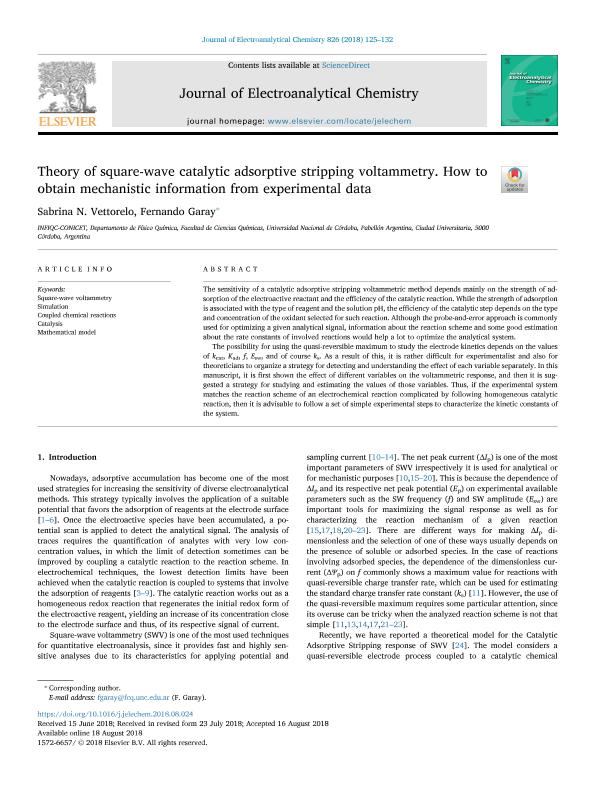Mostrar el registro sencillo del ítem
dc.contributor.author
Vettorelo, Sabrina Noel

dc.contributor.author
Garay, Fernando Sebastian

dc.date.available
2019-10-08T17:42:29Z
dc.date.issued
2018-10
dc.identifier.citation
Vettorelo, Sabrina Noel; Garay, Fernando Sebastian; Theory of square-wave catalytic adsorptive stripping voltammetry. How to obtain mechanistic information from experimental data; Elsevier Science Sa; Journal of Electroanalytical Chemistry; 826; 10-2018; 125-132
dc.identifier.issn
1572-6657
dc.identifier.uri
http://hdl.handle.net/11336/85335
dc.description.abstract
The sensitivity of a catalytic adsorptive stripping voltammetric method depends mainly on the strength of adsorption of the electroactive reactant and the efficiency of the catalytic reaction. While the strength of adsorption is associated with the type of reagent and the solution pH, the efficiency of the catalytic step depends on the type and concentration of the oxidant selected for such reaction. Although the probe-and-error approach is commonly used for optimizing a given analytical signal, information about the reaction scheme and some good estimation about the rate constants of involved reactions would help a lot to optimize the analytical system.The possibility for using the quasi-reversible maximum to study the electrode kinetics depends on the values of kcat, Kad, f, Esw, and of course ks. As a result of this, it is rather difficult for experimentalist and also for theoreticians to organize a strategy for detecting and understanding the effect of each variable separately. In this manuscript, it is first shown the effect of different variables on the voltammetric response, and then it is suggested a strategy for studying and estimating the values of those variables. Thus, if the experimental system matches the reaction scheme of an electrochemical reaction complicated by following homogeneous catalytic reaction, then it is advisable to follow a set of simple experimental steps to characterize the kinetic constants of the system.
dc.format
application/pdf
dc.language.iso
eng
dc.publisher
Elsevier Science Sa

dc.rights
info:eu-repo/semantics/openAccess
dc.rights.uri
https://creativecommons.org/licenses/by-nc-sa/2.5/ar/
dc.subject
SQUARE-WAVE VOLTAMMETRY
dc.subject
SIMULATION
dc.subject
CATHALYSIS
dc.subject
MATHEMATICAL MODEL
dc.subject.classification
Físico-Química, Ciencia de los Polímeros, Electroquímica

dc.subject.classification
Ciencias Químicas

dc.subject.classification
CIENCIAS NATURALES Y EXACTAS

dc.title
Theory of square-wave catalytic adsorptive stripping voltammetry. How to obtain mechanistic information from experimental data
dc.type
info:eu-repo/semantics/article
dc.type
info:ar-repo/semantics/artículo
dc.type
info:eu-repo/semantics/publishedVersion
dc.date.updated
2019-09-30T18:50:27Z
dc.journal.volume
826
dc.journal.pagination
125-132
dc.journal.pais
Países Bajos

dc.journal.ciudad
Amsterdam
dc.description.fil
Fil: Vettorelo, Sabrina Noel. Consejo Nacional de Investigaciones Científicas y Técnicas. Centro Científico Tecnológico Conicet - Córdoba. Instituto de Investigaciones en Físico-química de Córdoba. Universidad Nacional de Córdoba. Facultad de Ciencias Químicas. Instituto de Investigaciones en Físico-química de Córdoba; Argentina
dc.description.fil
Fil: Garay, Fernando Sebastian. Consejo Nacional de Investigaciones Científicas y Técnicas. Centro Científico Tecnológico Conicet - Córdoba. Instituto de Investigaciones en Físico-química de Córdoba. Universidad Nacional de Córdoba. Facultad de Ciencias Químicas. Instituto de Investigaciones en Físico-química de Córdoba; Argentina
dc.journal.title
Journal of Electroanalytical Chemistry

dc.relation.alternativeid
info:eu-repo/semantics/altIdentifier/doi/https://doi.org/10.1016/j.jelechem.2018.08.024
dc.relation.alternativeid
info:eu-repo/semantics/altIdentifier/url/https://www.sciencedirect.com/science/article/pii/S1572665718305538
Archivos asociados
